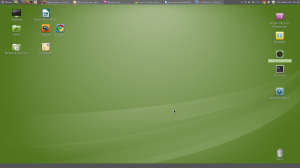There's trouble with three major Linux desktop application developers

The Linux desktop has long had most of the apps anyone could ever really need. Sure, it doesn't have some specific applications, like Adobe Photoshop or Quicken, but it had other apps. Such as Gimp for Photoshop and GNUCash for Quicken and QuickBooks that can do the job. Lately, however, companies that have supported Linux are moving away from the Linux desktop and that worries me. These companies and groups are: Adobe, Google, and Mozilla.
The first one doesn't come as much of a surprise. Adobe has long had a “difficult” relationship with Linux. We, the Linux community, wanted the full Adobe suite and what we got was Adobe AIR, Flash, and Acrobat. Well, we used to get AIR and Flash anyway. In February, Adobe announced that Adobe Flash Player 11.2 would be the last native version for Linux.
Newer versions of Flash will still be available for Linux... if you use the Chrome Web browser with its Flash Player browser plug-in. Listen, I love the Chrome Web browser, but I don't love feeling like I'm forced to use it because Adobe won't release a universal plug-in for any browser.
Now, some people hate Flash. For them, this is just another nail in Flash's coffin as HTML5 slowly takes over its place in delivering video, animation and games to users. That's a nice idea, but the bottom line is today the vast majority still rely on Flash, and not on HTML5, for all those elements. A Web browser without Flash support in 2012 is a crippled Web browser.
There are open-source alternatives to Adobe Flash. My favorite is GNU Gnash, but it hasn't kept up with the latest Flash formats.
Adobe AIR is dead. The badly out of date Air 2.6 is still available for Linux, but “Adobe has discontinued support for Adobe AIR for Linux operating systems.”
As for Adobe Acrobat Reader, Linux is not listed as an Acrobat X supported platform. Adobe Reader 9.4.7 is the latest available version for Linux. In stark contrast Windows users' can now download Acrobat 10.1.3. The open-source PDF readers, however, are better than their Flash cousins. I recommend KDE’s Okular myself if you want to read PDF and avoid Adobe's offerings.
Google is perhaps the oddest case with its hot and cold support for the Linux desktop. Google runs Linux itself on its servers. You could argue that Google is Linux's biggest success story.
On the other hand, Google has pulled support from Picasa for Linux, a simple, good photograph archiving and editing program. There are many other easy Linux photo programs, like Shotwell, but I always liked Picasa and I was surprised and ticked off to see Google shut Picasa down.
In addition, while I really like Google Drive, Google's personal cloud storage service, I wasn't happy that Google didn't immediately bring out native Google Drive support for Linux. It's coming real soon now, but it's still not here today.
Moving along, while it is indeed great that Google Chrome supports Flash, I find it more than a little annoying that, thanks in part to this, you can watch Netflix movies on Chromebooks or PCs running Chrome OS, which is just the Chrome Web browser running on top of Linux, but you can't watch the same videos with Chrome on any other Linux distribution. I mean come on guys, let's make this happen!
Finally, there's Mozilla, Firefox's parent group. The Mozilla crew is working on a way to install native Web applications on a browser's operating system. In short, they want to invent yet another app. Store. That's all well and good, but they won't be supporting it on Linux. At least, it won't be in Linux at first anyway.
Some Mozilla developers seem upset that it's been discovered they've placed Linux on the back-burner. On the other hand, it also seems to have lit a fire under some of them to take developing for Linux more seriously again.
And, that last part is a good thing. What I see happening here is that too many companies and programmers, ones that should know better, have started neglecting the Linux desktop.
Sure, the Linux desktop is a small market, but it's also a vital one that many of the world's best programmers and developers use every day And, besides the server side of Linux is what makes some of the biggest 21st century businesses go and the mobile side, Android, is in more smartphones than any other operating system. I hope that Adobe, Google and Mozilla all realize that since they're already supporting Linux in so many other venues they also need to keep supporting it with vigor on the desktop as well.
Related Stories:
Fedora 17 & GNOME 3.4: Return to a useful Linux desktop (Review)
Dell readies Ubuntu Linux laptop for developers
Here's why Linux is innovating on the desktop
